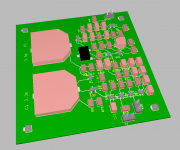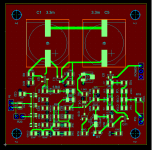with apologies to the late great C&W comedian.
pretty much Wayne's design except for the use of NSVJ5908 dual JFETs throughout, and a SMT P-Channel similar to the ZVP3310. The NSVJ5908's have a 1dB noise figure and transconductance of 35mS.
It will have to run cooler than the "real" Pearl as the OnSemi JFETs have VDS limited to 15V. The 3,300uF caps are also a limiting factor.
Made the decision to keep the regulation off this board, and to use a 4-layer board.
pretty much Wayne's design except for the use of NSVJ5908 dual JFETs throughout, and a SMT P-Channel similar to the ZVP3310. The NSVJ5908's have a 1dB noise figure and transconductance of 35mS.
It will have to run cooler than the "real" Pearl as the OnSemi JFETs have VDS limited to 15V. The 3,300uF caps are also a limiting factor.
Made the decision to keep the regulation off this board, and to use a 4-layer board.
Attachments
Any progress to share?
I tidied it up a bit, and have had the time to work with the NSVJ5908 JFETs -- they are only slightly noisier than the BF862, and in quantity of 10 about $0.75 apiece. (I did get an SMT test adapter which allows rapid matching with my Peak).
Placed as many of the circuit traces as possible on the topside. Inner Copper 1 is Vcc, Inner Copper 2 is Ground, Bottom Copper is Vee.
Just what I needed-another construction project.
But really, this is terrific. I have never really liked big, showy, equipment and this Pearl now has the added advantage of being small. (I really prefer small and pretty-kind of like my long suffering wife!). In fact, I wonder if the Mini Pearl could be installed into my turntable and potentially decrease the potential for induced hum.
Thanks for doing this.
But really, this is terrific. I have never really liked big, showy, equipment and this Pearl now has the added advantage of being small. (I really prefer small and pretty-kind of like my long suffering wife!). In fact, I wonder if the Mini Pearl could be installed into my turntable and potentially decrease the potential for induced hum.
Thanks for doing this.
The JFETs are RF devices, in most of the low noise amplifiers it's sometimes necessary to isolate each gate with a 200nH ferrite bead. I am trusting to the fates that the low impedance of the damping resistor and capacitor attend to this.
The boards are designed 2.500 x 2.500 inches. Ebay has quite a number of sellers of "Rectangular tin box" that would fit a pair.
The boards are designed 2.500 x 2.500 inches. Ebay has quite a number of sellers of "Rectangular tin box" that would fit a pair.
Not +/- 24V!!! -- the NSVJ5908's are good to 15V.What’s the intended PSU voltage?
Perfect. I have a SuperReg needing something to do...
You could also run it from a "Silent Switcher" --
There may be one or two resistor parameters which have to change, but it simulates pretty well @+/-15V
I asked because I've been following these regulators since "Sulzer" and the articles were sooo adamant that the particular components specified were critical.
And then I got here at diyaudio and it's almost "any old cap'll do".
Except for the output cap. That had to be "ordinary". Huh?
It's just a tiny bit inconsistent. And some of us just want to build the thing not be forced to play around even as a learning experience. Asking what has worked is just a different perspective on learning, one that that gets to the end game... the music. Just sayin'.
Of course if gold plating would help. I wouldn't know or expect that it would. That notion was not explicit or implicit in my question.
That said I appreciate all the help you provide... as must do many others here.
And then I got here at diyaudio and it's almost "any old cap'll do".
Except for the output cap. That had to be "ordinary". Huh?
It's just a tiny bit inconsistent. And some of us just want to build the thing not be forced to play around even as a learning experience. Asking what has worked is just a different perspective on learning, one that that gets to the end game... the music. Just sayin'.
Of course if gold plating would help. I wouldn't know or expect that it would. That notion was not explicit or implicit in my question.
That said I appreciate all the help you provide... as must do many others here.
One who will remain nameless has done some work on stability and different capacitor types. As long as the ESR is above about 100 milliOhms the SR will remain stable. You can demonstrate this in LTSpice by stepping the ESR parameter of the output cap. Those specified in the 1995 article disappeared from production almost as soon as the ink was dry!
Bypassing the error amplifier, using a low ESR or film cap on the output are fraught with issues.
Bypassing the error amplifier, using a low ESR or film cap on the output are fraught with issues.
- Home
- Amplifiers
- Pass Labs
- Mini Pearl


